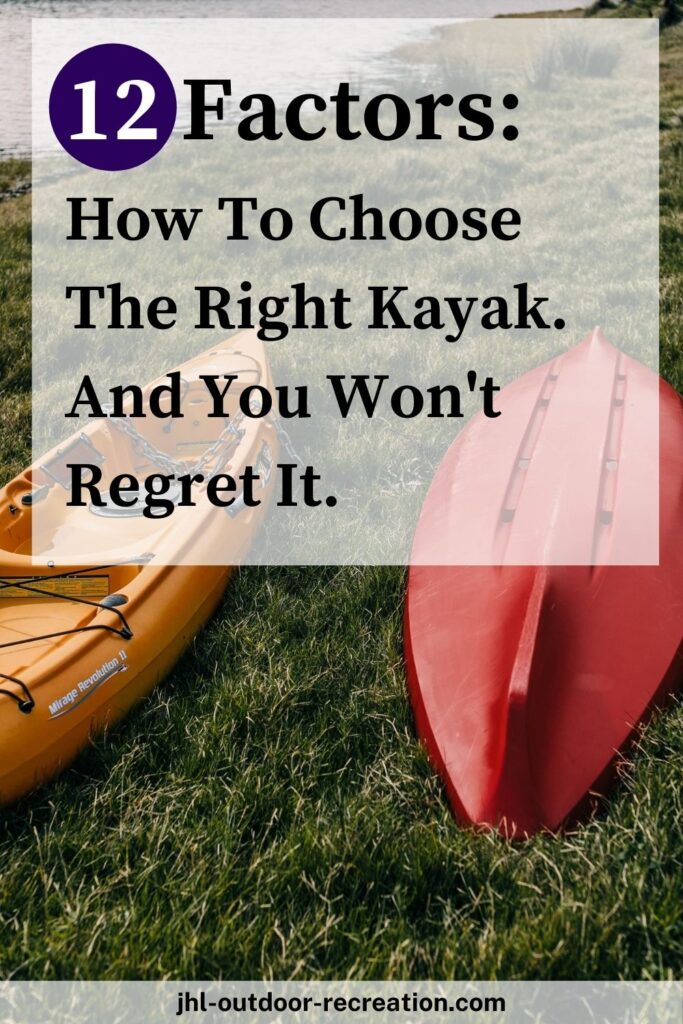Whether you are experienced in or new to kayaking, here’s a question for you. Do you think it is easy to choose the right kayak that you want?
Well, you might think that kayak is just a boat. You just need a boat to paddle on the river or on the lake. You don’t have to consider so much.
I want you to imagine this. You step inside a kayak shop, or you wanna shop online, you see varieties of kayaks. They are in different sizes, shapes, lengths and widths, and even the brands. – So, why don’t they standardize the kayaks to make our lives easier?
Here’s a thing. Choosing the right kayak is a skill that you need to master. In fact, there are a lot of factors that you need to consider when you want to choose the right kayak.
So, in this post, we are gonna discuss the 12 relevant factors on how to choose the right kayak.
1. Types of kayak
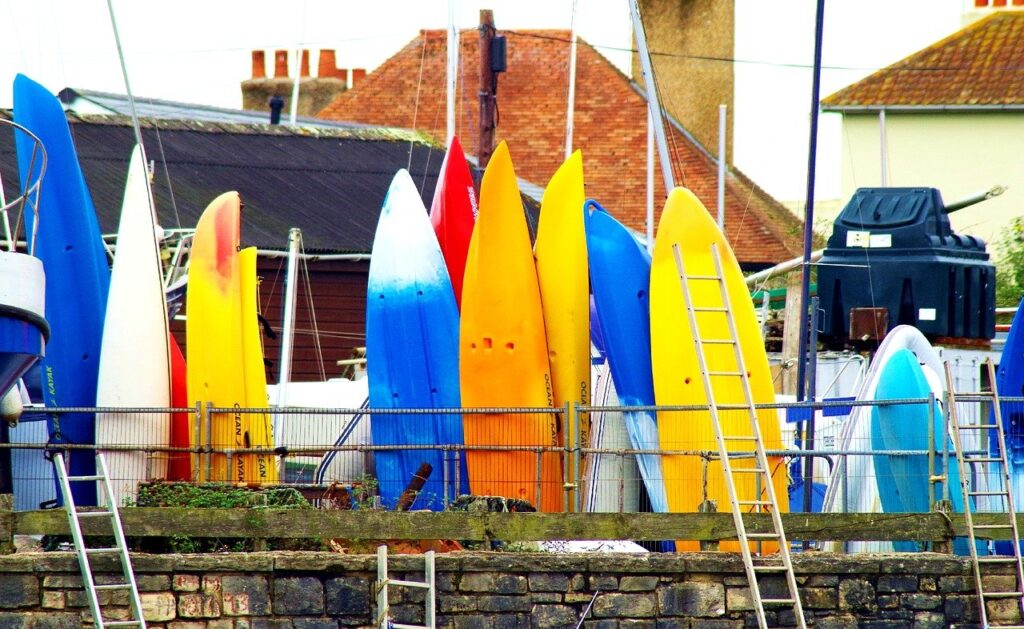
Yeah, kayaks come with various types. Of course, they serve their own functions. Though it might be overwhelming to classify them, kayaks can be broadly categorized into the following categories.
1.1 Sit-On-Top kayaks
The common characteristics of these kayaks include:
- Open cockpit
- With or without storage space
- Wide and bulky body
This is ideal for RECREATIONAL paddling. Wide and bulky kayaks are very stable on the water. Hence, they are quite difficult to capsize.
Even when the kayaks capsize, paddlers can easily escape from the kayaks because of the open cockpits. Hence, this reduces the chance of drowning.
However, the stability compromises the speed of moving through the water. So, you don’t expect Sit-On-Top kayaks outpace the lean and long kayak.
Also, expect to get WET while paddling on Sit-on-top kayaks. You can’t wear a spray skirt because of the open cockpit. In some cases, kayaks are drained automatically due to the design, so you don’t need a water pump to pump the water out.
1.2 Sit-Inside kayaks
Opposite of Sit-On-Top kayaks. The common characteristics are:
- Close cockpit
- Usually with storage at the bow and stern of kayaks (1 or 2 storage spaces)
- Long and narrow body
In terms of stability, it is not as good as Sit-On-Top kayaks, due to the long and narrow body of kayaks. However, paddlers can manage the SECONDARY stability, ie. stability of kayak when wobbling.
Close cockpit allows paddlers to wear a spray skirt when paddling to prevent water entering the kayak. So, they can avoid getting wet when paddling.
However, when capsizing, paddlers with spray skirts have the risk of getting trapped inside the kayaks. Hence, this might increase the chance of drowning. To avoid this, paddlers need to learn wet exit or rolling drills.
The biggest advantage over Sit-On-Top kayaks is paddlers are able to paddle faster on Sit-Inside kayaks.
1.3 Touring / sea kayaks
Usually come under Sit-Inside kayaks. So, the generally characteristics are similar to the typical Sit-Inside kayaks.
- Close cockpit
- More storage spaces (at least 2)
- Much longer and narrower body
As the name suggests, these kayaks are suitable for touring or sea kayaking, especially for long mileage kayaking session.
The long and narrow body not only helps paddlers navigate better and more efficiently when paddling on the ocean, but also makes paddlers easier to roll the kayak back to the original position when capsizing.
1.4 Whitewater kayaks
Another variation of Sit-Inside kayaks. And, the common characteristics are:
- Close cockpit
- Usually no storage available
- Much shorter and bulkier body
These kayaks are designed for whitewater kayaking. The shorter and bulkier (and rounder) body makes paddlers MANEUVER better under rocky and turbulent environment.
Because of the nature of paddling, wearing a spray skirt is essential to prevent the water entering the kayaks and also allow the paddlers roll the flipped kayaks.
1.5 Canoe / Kayak hybrids
Hybrid between a kayak and canoe. Hence, the common characteristics are:
- Wide and open cockpit
- The whole vessel is a storage (typically like a canoe)
- Big and wide body
Well, you get the idea that these kayaks aren’t suitable for speed or efficiency due to the bulky size of the kayaks. Due to the big space for storage and the size of the kayaks, they are perfect for FISHING and KAYAK CAMPING.
And of course, canoe / kayak hybrid is a good choice if you want to paddle with your pets.
However, expect to get wet when paddling because you cannot use a spray skirt to prevent getting wet. So, remember to bring a water-pump to pump the water out of the kayak if necessary.
1.6 Inflatable kayaks
Inflatable kayaks come with various sizes and designs. But, they are the inflatable version of Sit-On-Top or canoe / kayak hybrids. Usually, they come in 1 piece.
The biggest motivation for having inflatable kayaks is the transportation and storage. You didn’t have to worry about these if you had an inflatable kayak. Apart from this, they are quite cheap generally.
However, they are for RECREATIONAL paddling because of the stability. Hence, you don’t expect to paddle fast on an inflatable kayak.
Apart from this, the other weaknesses are:
- Not comfortable for tall paddlers
- Take some time to set up the kayak
- Even take more time to deflate and drain the kayak
- Inherent safety issue when there is puncture and damage
1.7 Folding kayaks
These serve the same purpose as inflatable kayaks. The main motivation is easy for transportation and storage.
Folding kayaks come with various sizes and designs. Usually, they come in 2 pieces, ie. the shell and the skeleton (or scaffold structure). However, you may find those better-designed folding kayaks in 1 piece, too.
The set up and dismantling, however, might be time consuming at the very beginning. But, once you get used to the process, they might come in handy and shouldn’t be an issue anymore. – Just like how you set up and dismantle a tent.
Unlike inflatable kayaks, folding kayaks are better for paddling efficiency. Literally, you can paddle faster and in a straight line on a folding kayak. Well, this also means that the price of folding kayaks is usually at the premium level.
2. Purpose
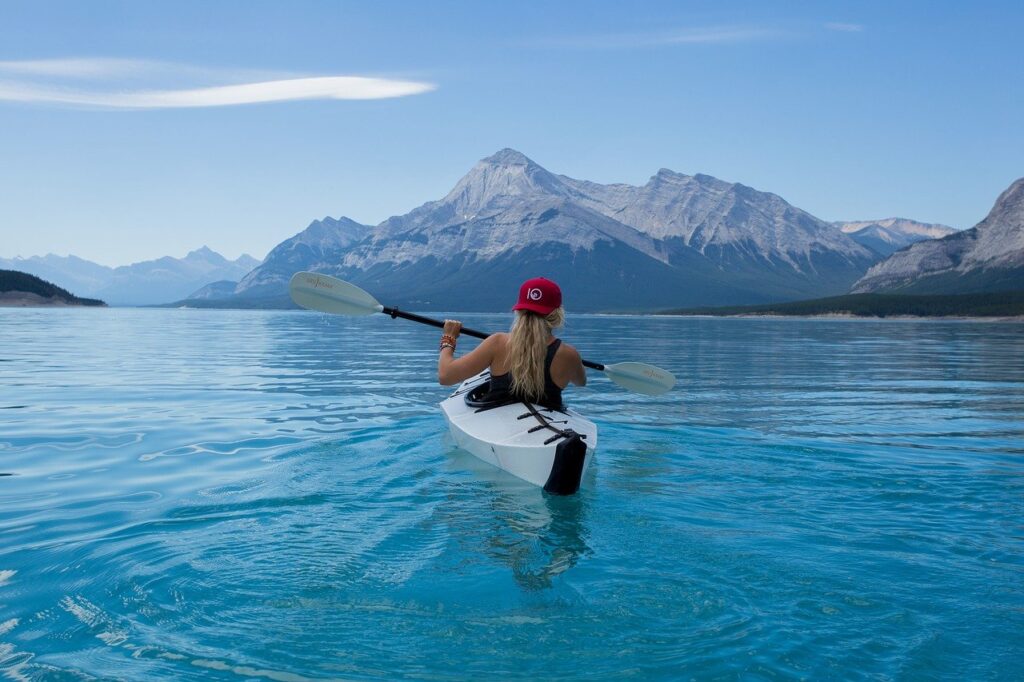
You need to understand the types of kayak than you are going to choose to fit your purpose. – It’s that simple.
Get to know whether you paddle for recreational or non-recreational purposes. Recreational paddling is straight forward. You don’t need to focus on the speed, but rather focus on the navigation through the water.
Non-recreational paddling, however, is a bit trickier. You need to identify which of the following applies to your purpose:
- Speed – There you go with a Sit-Inside kayak
- Maneuverability – Crucial for whitewater kayaking. In this case, you need a whitewater kayak.
- Touring – So, you want a long distance kayaking trip. Perhaps also kayak camping. In this case, a sea kayak or a canoe / kayak hybrid might be your choices.
After knowing the types of kayak and your purpose, you already have a general idea on how to choose the right kayak.
But, it is insufficient yet, as there are other factors that can influence your decision.
3. Usage expectation
Let’s have a deeper thought. How long do you want to use the kayak? And, how much do you want to use it?
To give you some guidance, let’s look at the factors below.
3.1 Frequency
Ask yourself the question and see which category you fall into.
- Category 1: Annually? Semi-annually? Quarterly?
- Category 2: Monthly? Bi-weekly? Weekly
Obviously, if you fall into the first category, you won’t use the kayak very often. Hence, if you bought a high-end kayak, it might be a waste. – In other words, you choose PRICE over quality.
Likewise, if you fall into the second category, this means you will use the kayak frequently. So, you might put emphasis on the QUALITY, rather than the price.
3.2 Duration
Similar to frequency. For long paddling sessions, such as camping or touring, you have to focus on the QUALITY of kayak.
Likewise, for short sessions, such as 1- or 2-hour paddling, PRICE can be your priority, unless you’re gonna use it very frequently.
4. Number of paddlers
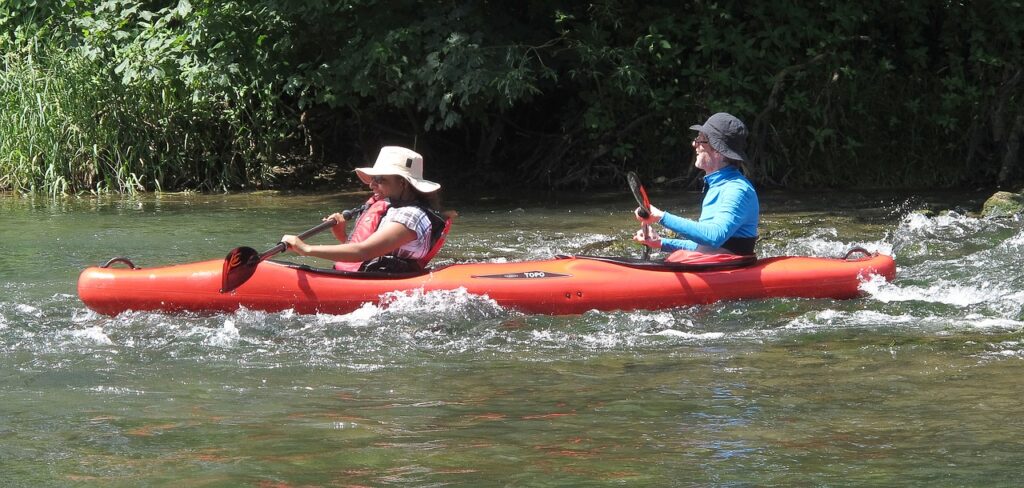
So, are you gonna paddle alone? Or, do you have paddling buddies with you? While we always think of single kayaks for the discussion, we shouldn’t ignore tandem kayaks as well.
When you are going to paddle with someone else, you need to consider this factor. For example, do you guys want to paddle separately on single kayaks or paddle together on a tandem kayak?
There is a benefit for each occasion:
- Single kayaking – You control the speed and navigation all by yourself. You don’t need to worry about the synchronization and quarrel with your paddling buddy.
- Tandem kayaking – It can be fun because you guys can learn to collaborate and synchronize while kayaking. Thus, it improves relationships.
If you chose a tandem kayak, you might need to consider the transportation and storage, due to the size and length of the kayak. – But, the perk is you might be able to share the cost with your paddling buddy.
But, if you chose single kayaks, you might need to consider the price, as in you aren’t gonna buy 1 single kayak, but more than 1 actually. – Think of your budget.
5. Materials of kayak
Why should we care about materials? Does that make any difference?
The answer is: YES. Apart from the impact on the paddling efficiency, it also has impact on the price of kayaks.
Again, there are various types of materials for kayaks. And, the common materials are:
5.1 Wood
Surprisingly, it is a fancy material for kayaks. You seldom see wooden kayaks because they are unique. – Just like a wooden piano, as they are under the same category.
You need an expert to build a customised wooden kayak. Because of that, it is an art and is distinct to each other. – Meaning, the kayak is One and Only.
Wooden kayaks are usually protected by the layer of fiberglass with resin and varnish. Hence, this makes wooden kayaks even stronger.
However, they are not suitable for paddling on rapid water and rocky surface. Thus, you don’t have to consider this for whitewater kayaking. – You know it. This can damage the kayak easily.
5.2 Polyethylene
Polyethylene is a type of plastic. The kayaks are also known as Rotomolded Kayaks. The manufacturing process is quite straight forward.
Polyethylene power is poured into a mould and then it gets heated. When it is cooled, it forms a 1-PIECE kayak.
These kayaks are very durable. They are good for paddling under rocky and turbulent condition. Hence, you can see a lot of whitewater paddlers using Rotomolded Kayak.
The kayaks can be difficult to repair though, if there is any damage and leakage. Plus, it is vulnerable to UV light. So, it is a bad idea to let it expose under the sunlight for an extended period.
The kayaks are usually cheap but heavy. So, think twice if you wanna buy a light kayak.
5.3 Composite
The materials of kayak usually consist of combination of fiberglass, carbon fiber and Kevlar. The kayaks are built by PIECE-BY-PIECE lamination. In fact, it is very time-consuming.
These kayaks are very stiff and light, thanks to the nature of the elements. So, they are very responsive to paddling on the water, hence faster and more efficient paddling.
Due to the strength of these elements, composite kayaks are very durable. Also, relatively they are easy to repair if there is damage on the kayaks.
So, the result is: composite kayaks are high-performing kayaks. – And expensive as well!
5.4 ABS thermoforming
Another type of plastic. Unlike Rotomolded kayaks, ABS thermoforming kayaks are 2-PIECE kayaks, meaning the processes of making the hull and the deck are separate and the pieces are joined together thereafter.
Don’t get confused by the jargon. It involves a process where it uses vacuum to suck the heated plastic sheet on the mould. Then, it forms the shape accordingly. – This is similar to those transparent or white plastic covers of electronic devices.
They have UV layer as protection. So, generally speaking, they can be more durable than Rotomolded kayaks.
The biggest drawback is flexibility. Don’t misinterpret it. Flexibility, in kayaking, is a weak feature because it means “not quite” responsive to paddling. – In other words, inefficient paddling.
5.5 PVC or polyurethane
Also types of plastic materials. Both materials are usually used for inflatable kayaks.
So, you don’t expect stiffness for inflatable kayaks. And, don’t expect you can paddle fast and efficiently.
Well, they are same as inflatable pools or bath tubs. So, literally you cannot expect anything. – And, what can you expect?
5.6 Materials for folding kayak
Folding kayaks consist of 2 parts, ie the outer shell and the inner installable scaffold (boat frame). Rubber or PVC is usually the material for the outer shell whereas aluminum or wood is the material for the boat frame.
Unlike inflatable kayaks, folding kayaks resemble the design of solid kayaks, to mimic the performance and effectiveness, at the same time to make it easier to transport and store. – Thus, they aren’t as bulky as inflatable kayaks.
Folding kayaks usually start with the high-end price range. So, don’t expect to get a cheap folding kayak if you have a budget for an inflatable kayak.
6. Transportation & storage
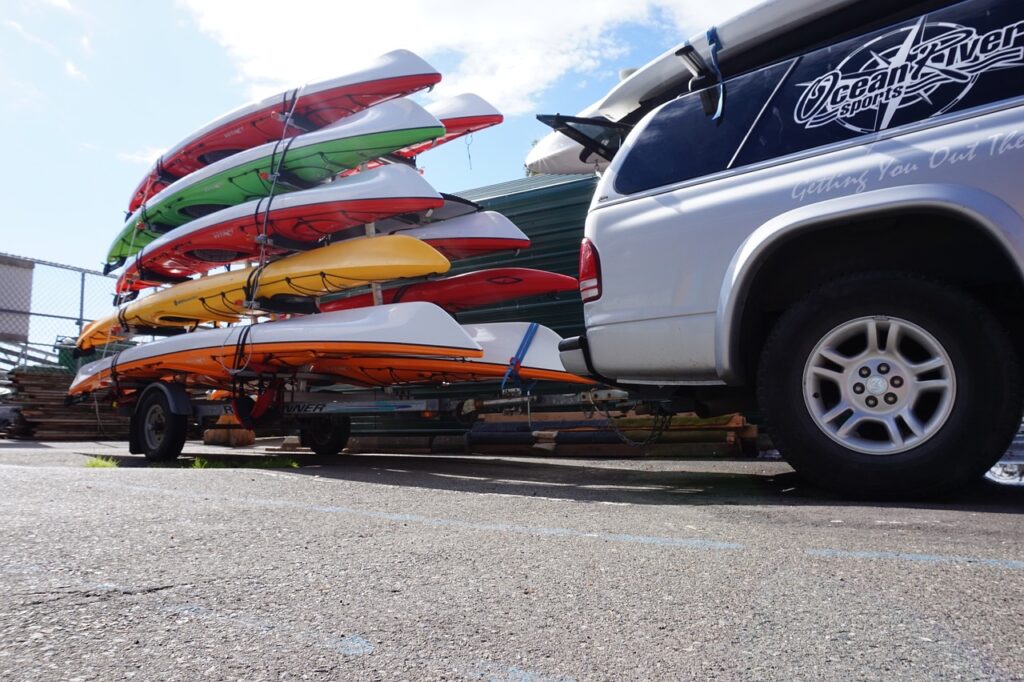
Everyone should be able to carry a kayak without any issue. – This is how the way it is.
Nevertheless, it doesn’t mean we don’t have to concern about the transportation and storage for kayaks. In fact, this is the most critical factor to consider before you want to buy the right kayak.
First of all, are you capable to transport a hard-shell kayak? Is your car capable to do so? You need to install a rack on your car for this purpose. Do you know how to install it? And, what if you scratched your car because of the rack and kayak, were you ok with that?
When it comes to storage, it should be no problem if you have a garage or backyard to store the kayak. But, what if you stayed in apartment and there was no space to store it?
That is why inflatable kayaks and folding kayaks come in handy. In fact, they are gaining their popularity because of the ease of transportation and storage.
Just a size of a golf bag, literally you can store anywhere and carry it without any issue.
7. Footwells / foot braces
Both footwells and foot braces allow you to place your feet properly when paddling. They aren’t essential for kayaking but still, they are quite useful and worth to be considered before you choose the right kayak.
They help maintain and stabilize the sitting posture to enhance torso rotation. In other words, they promote paddling efficiency.
Footwells are the intervals of various foot-placing on both sides of the bow of the kayak, so you can place your feet at any interval, depending on your height. They are like shark gills. Usually, they are available on Sit-On-Top kayaks.
Foot braces, on the other hand, are ADJUSTABLE which you can install them on both sides of the bow of the kayak. You can adjust the foot placement according to your height.
However, not all kayaks have foot braces. It is great when foot braces come in a package with the kayak. But, if foot braces were not available, then you might need to buy and install them manually.
8. Rudder & skeg
These are also additional accessories for kayaks. Skeg is an “inverted shark-fin figure” on the keel of kayak. Rudder, on the other hand, is a blade installed on the stern of the kayak.
Ok, why are rudder and skeg important? It is because they help stabilize the kayak so that paddlers can steer and navigate the kayak easier. Thus, they help prevent the kayak wobble and make the kayak move in a straight line easier.
Look for a kayak either with a rudder or a skeg. They are particularly useful for long kayaking session. You avoid the wobbling or zigzag moving pattern which can frustrate you easily.
9. Gears & items
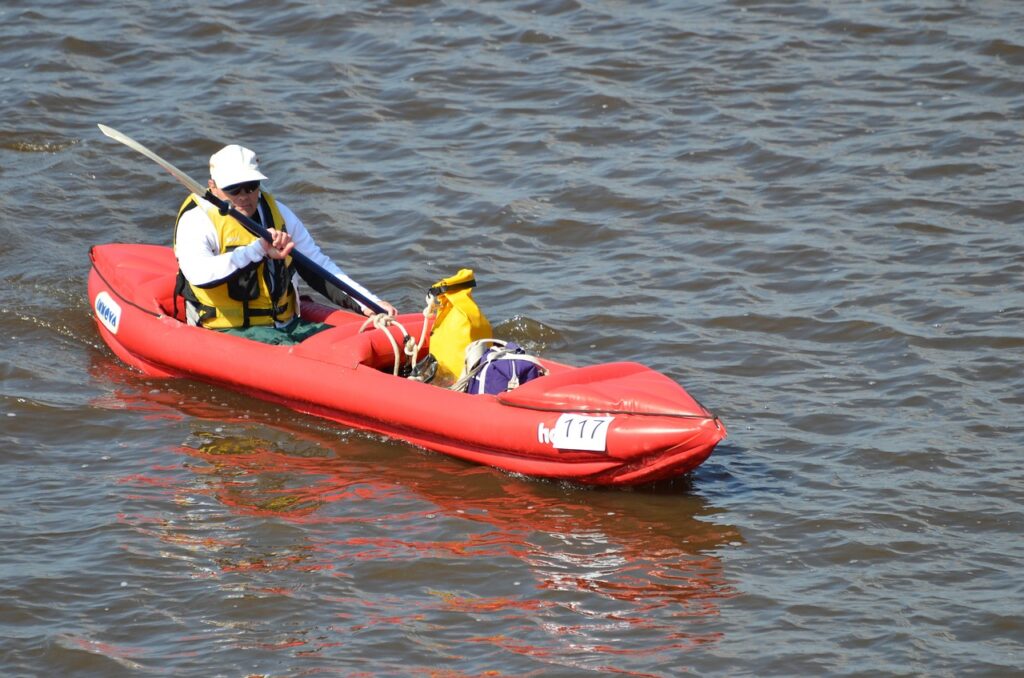
Kayaks have various designs: some kayaks have multiple storage spaces (hatches), and some kayaks might not have any storage space at all.
However, usually kayaks have either 1 or 2 storage spaces at the bow and the rear of the kayak. And, this is sufficient for normal occasion.
But, if you were planning for fishing, camping, or even touring, then 2 storage spaces might not be sufficient. So, you need to consider a kayak with a lot of storage spaces.
In this case, you can consider a sea kayak or even a canoe / kayak hybrid.
10. Price
Though price is a common factor, PRICE should always be the non-dominant factor. Think about it. When you want to choose the right kayak, the main factors would always be your purpose and the types of kayak.
These dictate the materials and other features of your perfect kayak. And these dictate the price.
With all that being said, the price of kayak varies greatly depending on the types and materials of kayak. It can be as cheap as hundred dollars or as expensive as a few thousand dollars.
That is why you need to know the features of kayak and create your own REASONABLE budget. For example, you won’t expect $100 for a composite kayak.
Consider your purpose and the types of the kayak that you want to buy. Then, match your budget. You wanna find a kayak which fits your expectation and your budget.
11. Kayak testing
This is not applicable if you chose to buy online. But, if you are going to buy at a kayak shop, then you might want to test the kayak.
Whether you agree with me or not, buying a kayak is like buying a car, motorbike or even a bike. – Essentially, buying a kayaking is buying a VEHICLE!
If kayak testing is available, don’t waste the chance. Go test your kayak! You know whether the kayak is right for you or not!
You need to get the feeling and feel comfortable sitting and paddling on the kayak, because most probably you need to use it for quite a long period.
In fact, shortlist a few kayaks, test them all, and choose the best kayak that is right for you!
12. Resale value of kayak
The factors of resale value of kayak are very similar to the price of the kayak. These common factors are: materials, types, conditions, age and brand of kayak.
Generally, the older and more wear and tear of the kayak is, the lower the resale value is. For example, if the used kayak is 5 years old, the resale value could be 55% of the original price of the kayak. For 10-year-old kayak, the value could be 15% of the original price of the kayak.
But, the resale values may change accordingly, depending on the conditions and maintenance of the kayak.
12.1 Why do we need to know the used value?
There are 2 main reasons for this.
Reason 1 – Cost recovery. This is crucial if you intend to use it temporarily and upgrade to a better kayak in the near future. Because of the size of the kayak, you won’t want to keep it in your garage forever when you don’t want to use it anymore, right?
So, get to know the resale value and sell it to the next person to recover your cost of buying the new kayak.
Reason 2 – Buy a used kayak. It is always preferable to buy a new kayak because of guaranteed condition. But, let’s face it. Many people want to buy a good quality kayak and yet they don’t afford to pay the original price.
Instead of compromising your expectation, the next solution would be looking for a used kayak.
Final thought: choose the right kayak
Buying a right kayak is essentially buying a vehicle. When you want to choose the right kayak, don’t rush when buying it.
You need to spend some time and efforts to do the research on what kinds of kayak that you wanna buy.
It’s tedious, I know. But, your efforts and time pay off when you know exactly the right and perfect kayak to choose. Otherwise, you will regret buying the kayak that you don’t like and doesn’t fit your purpose, at all!
Relevant posts
